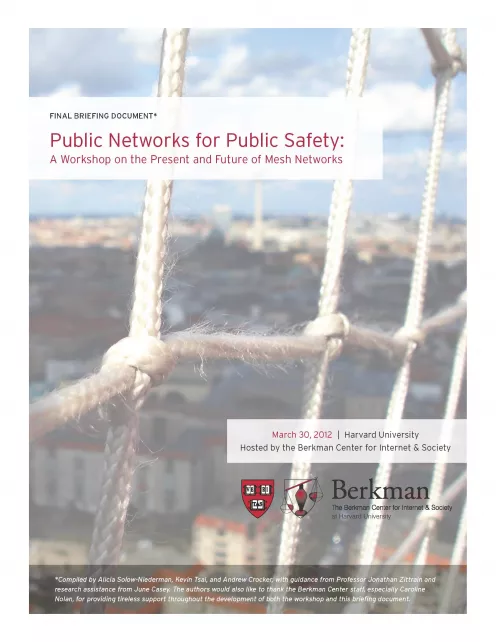
Briefing Document: Public Networks for Public Safety
A Workshop on the Present and Future of Mesh Networks
The Berkman Center for Internet & Society is pleased to present this briefing document, which was developed as part of our March 30th, 2012,
workshop on "Public Networks for Public Safety: A Workshop on the
Present and Future of Mesh Networking.” This workshop provided a starting point for conversation about whether
mesh networks could be adopted within consumer technologies to enhance
public safety communications and empower and connect the public while
simultaneously improving public safety. Participants in this initial
convening, detailed on page 33 of the briefing document, included
members of government agencies, academia, the telecommunications
industry, and civil society organizations; their helpful inputs were
integral to the final version of this document.
Building on the dialogue that occurred at this gathering, this briefing document seeks to:
- sketch a broad overview of mobile ad hoc networks (MANETs) and mesh technologies;
- identify critical technical issues and questions regarding the communications effectiveness of those technologies;
- explain how public safety communications relate to mesh and offer a synopsis of current regulations affecting those communications;
- describe a set of basic use cases that emerged from the conference;
- map out stakeholders at the technical, regulatory, legal, and social levels, and associated interests, points of connection, and potential challenges;
- catalog select examples and, where possible, highlight potential next steps and areas for short term action; and,
- summarize key takeaways from the conference, with an emphasis on shared principles or best practices that might inform participants’ diverse efforts to improve communications affordances for the public and the public safety community.
The paper also synthesizes several strains of workshop discussion that
probed big picture framing concerns that could inform the present and
future of mesh. Specifically, it puts forth two related but distinct
models for mesh: mesh in a technical sense and mesh as a metaphor or
social layer construct, with a particular emphasis on the need for
further conceptual development with regard to “social mesh.” The final
section emphasizes key take-aways from the event, highlighting core
principles and best practices that might both provide a theoretical
underpinning for the future conceptual development of mesh networking
technologies and social mesh models, respectively, and inform the
real-world development of communications systems that involve either
definition of mesh.
The Berkman Center thanks all of the workshop attendees both for their
participation during the event and for comments offered during the
development of this briefing document. Berkman Center Project
Coordinator Alicia Solow-Niederman worked closely with Professor
Jonathan Zittrain to plan and execute this event as well as to produce
this briefing document. Berkman Center Research Assistants Andrew
Crocker and Kevin Tsai provided exceptional contributions to this
briefing document, and June Casey contributed indispensable assistance
with background research.
The Berkman Center is hopeful that this final product will help frame
the issues, prompt consideration, and provoke ongoing discussion about
the present and future of mesh.
